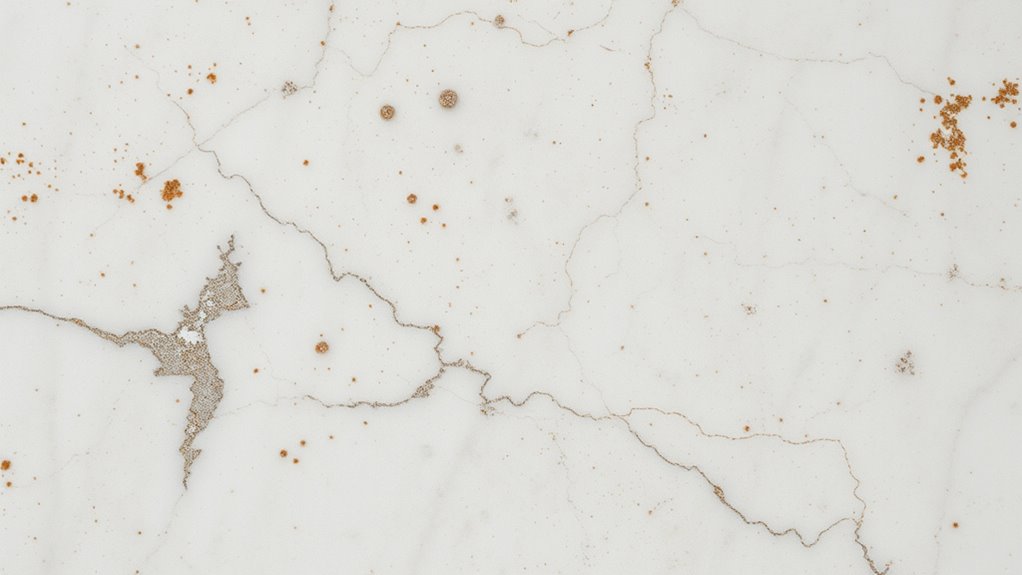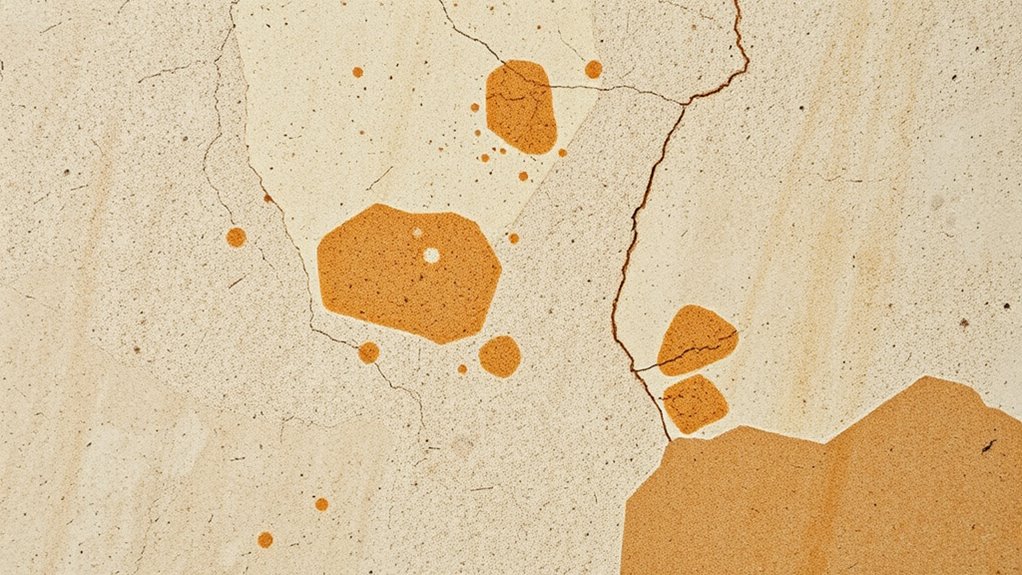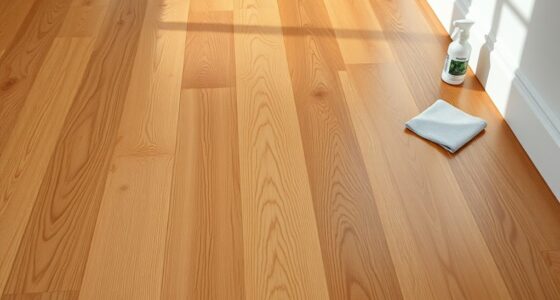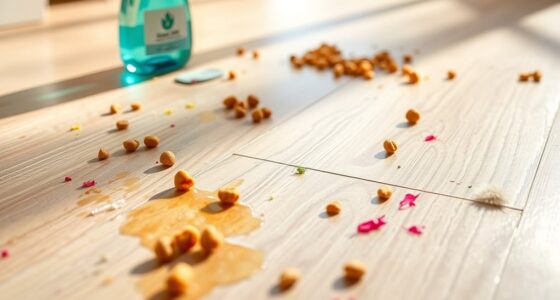One common mistake is using harsh or acidic cleaners like vinegar or lemon juice, which can etch and dull your natural stone. Neglecting to reseal the surface regularly also leaves it vulnerable to stains and damage. Additionally, delaying spill cleanup and using abrasive tools can cause lasting harm. Sticking to gentle, pH-neutral cleaners and proper maintenance can preserve your stone’s beauty—keep going to discover simple tips to avoid these mistakes effectively.
Key Takeaways
- Avoid using harsh or acidic cleaners like vinegar or lemon juice that can etch and damage the stone surface.
- Don’t neglect resealing; reapply stone sealer every 6 to 12 months to maintain stain resistance.
- Clean spills immediately with soft cloths to prevent staining and seepage, especially on unsealed surfaces.
- Steer clear of abrasive tools such as steel wool or stiff brushes that can scratch or dull the stone.
- Test new cleaning products on small, inconspicuous areas first to prevent unexpected surface damage.

Cleaning natural stone can enhance its beauty, but many common mistakes can cause irreversible damage. One of the biggest errors you might make is using improper cleaning methods that harm the stone’s surface. For example, relying on harsh or acidic cleaners can eat away at the natural stone’s finish, leading to dullness or etching. Instead, you should focus on gentle, pH-neutral cleaners specifically formulated for natural stone. These cleaners protect the stone’s integrity and preserve its natural appearance over time.
Sealing techniques are also vital in maintaining your stone’s durability. Many people overlook the importance of sealing or assume one application is enough. In reality, sealing isn’t a one-time fix; it requires regular reapplication to keep the stone resistant to stains and moisture. When you properly seal your stone, it becomes less susceptible to spills and dirt penetration, making cleaning easier and preventing long-term damage. Make sure to follow the sealing manufacturer’s instructions and schedule resealing every 6 to 12 months, depending on your stone type and usage. Ignoring this step often leads to staining issues that are difficult to correct later.
Proper sealing and regular reapplication protect natural stone from stains and damage.
Another common mistake involves the use of acidic cleaners, which are highly damaging to natural stone surfaces. Acidic substances such as vinegar, lemon juice, or commercial bathroom cleaners can cause etching—permanent marks that dull the surface and destroy the natural finish. If you’re tempted to use these cleaners for their cleaning power or convenience, think again. Instead, opt for pH-balanced cleaning solutions that are safe for natural stone. Always test a small, inconspicuous area before applying any new cleaner to ensure it won’t cause harm.
Additionally, many people neglect to clean up spills immediately. Waiting too long allows liquids to seep into the stone, especially if it’s unsealed or poorly sealed. This can lead to staining or even structural damage over time. When you notice a spill, wipe it up promptly with a soft cloth and avoid abrasive scrubbing that can scratch the surface. Regular maintenance, like sweeping or dusting to prevent grit buildup, also extends the life of your stone.
Furthermore, understanding the global entertainment industry and the financial impact of major wrestling promotions can help you realize the value of investing in proper maintenance and care routines for your natural stone surfaces. Avoid using abrasive tools like steel wool or stiff brushes that can scratch or dull the stone’s surface. Stick to soft cloths, mops, or brushes designed for delicate surfaces. Proper cleaning and sealing techniques are simple but essential steps to ensure your natural stone stays beautiful and in excellent condition for years to come.
Frequently Asked Questions
Can Natural Stone Be Cleaned With Vinegar Safely?
No, you shouldn’t clean natural stone with vinegar because vinegar dangers can harm the surface. Its acidity can etch and dull the stone over time. Instead, use alternative cleaners specifically designed for natural stone, like pH-neutral solutions, to keep your surface safe. Always test a small, hidden area first, and avoid harsh chemicals to preserve the beauty and integrity of your natural stone.
How Often Should I Clean My Natural Stone Surfaces?
You might be surprised how often you should clean your natural stone surfaces. If you want to maintain their beauty and avoid damage, stick to a regular cleaning frequency—at least once a week for high-traffic areas and biweekly for others. Proper stone maintenance isn’t just about cleaning; it’s about timing. Miss the right intervals, and you risk stains or etching. Stay consistent, and your stone will thank you with lasting elegance.
Are Homemade Cleaning Solutions Effective for Natural Stone?
Homemade cleaning solutions can be effective for natural stone if you choose the right ingredients, like a mix of water and mild soap or baking soda. However, DIY cleaning may not always be as reliable as commercial cleaners designed specifically for natural stone, which are formulated to avoid damage. Always test any solution on a small area first, and use gentle, pH-neutral products to keep your surfaces pristine.
What Are the Signs of Damaged Natural Stone?
You’ll notice porous damage when your natural stone looks uneven or feels crumbly, indicating it’s absorbed moisture or stains. Surface etching shows up as dull, scratched areas where the stone’s protective surface has been compromised, often from acidic cleaners. If you see these signs, act quickly by avoiding harsh chemicals, sealing the surface, and consulting a professional to prevent further damage and maintain your stone’s beauty.
Is Sealing Necessary After Cleaning Natural Stone?
Sealing your natural stone is essential because it helps protect against stains and damage. The sealing importance can’t be overstated, especially after cleaning, as it restores the stone’s barrier. You should consider sealing frequency based on usage and type of stone—typically every 1-3 years. Regular sealing maintains its appearance and longevity, so don’t skip this step to keep your natural stone looking its best and well-protected.
Conclusion
Avoiding common natural stone cleaning mistakes can prolong the beauty and durability of your surfaces. Did you know that over 60% of stone damage occurs from improper cleaning methods? By using the right products and techniques, you can prevent costly repairs and keep your stone looking its best. Remember, a little extra care goes a long way—so take the time to learn proper cleaning habits and protect your investment for years to come.








